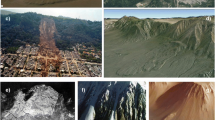Summary
In this work, we study the modeling of one-dimensional avalanche flows made of a moving layer over a static base, where the interface between the two can be time dependent. We propose a general model, obtained by looking for an approximate solution with constant velocity profile to the incompressible Euler equations. This model has an energy dissipation equation that is consistent with the depth integrated energy equation of the Euler system. It has physically relevant steady state solutions, and, for constant slope, it gives a particular exact solution to the incompressible hydrostatic Euler equations. Then, we propose a simplified model, for which the energy conservation holds only up to third-order terms. Its associated eigenvalues depend on the mass exchange velocity between the static and moving layers. We show that a simplification used in some previously proposed models gives a non-consistent energy equation. Our models do not use, nor provide, any equation for the moving interface, thus other arguments have to be used in order to close the system. With special assumptions, and in particular small velocity, we can nevertheless obtain an equation for the evolution of the interface. Furthermore, the unknown parameters of the model proposed by Bouchaud et al. (J Phys Paris I 4,1383–1410, 1994) can be derived. For the quasi-stationary case we compare and discuss the equation for the moving interface with Khakhar’s model (J Fluid Mech 441,225–264, 2001).
Similar content being viewed by others
References
Aradian, A.: Quelques problèmes d’interface mole. Ph.D. Thesis Paris VI (2001)
Aradian A., Raphael E. and Gennes P.-G. (2002). Surface flow of granular materials: a short introduction to some recent models. C. R. Phys. 3: 187–196
Aranson I.S. and Tsimring L.S. (2002). Continuum theory of partially fluidized granular flows. Phys. Rev. E. 65: 061303
Bouchut F., Mangeney-Castelnau A., Perthame B. and Vilotte J.-P. (2003). A new model of Saint Venant and Savage–Hutter type for gravity driven shallow water flows. C. R. Acad. Sci. Paris Ser I 336: 531–536
Bouchut F. and Westdickenberg M. (2004). Gravity driven shallow water model for arbitrary topography. Commun. Math. Sci. 2(3): 359–389
Bouchaud J.P., Cates M.E., Prakash J.R. and Edwards S.F. (1994). A model for the dynamics of sandpile surface. J. Phys. Paris I 4: 1383–1410
Boutreux T., Raphael E. and DeGennes P.G. (1998). Surface flows of granular materials: a modified picture for thick avalanches. Phys. Rev. E 58: 4692–4700
Douady S., Andreotti B. and Daerr A. (1999). On granular surface flow equations. Eur. Phys. J. B. 11: 131–142
Gray J.M.N.T. (2001). Granular flow in partially filled slowly rotating drums. J. Fluid Mech. 441: 1–29
Khakhar D.V., Orpe A.V., Andresén P. and Ottino J.M. (2001). Surface flow of granular materials: model and experiments in heap formation. J. Fluid Mech. 441: 225–264
Khakhar D.V. and Orpe A.V. (2001). Surface granular flows: two related examples. Adv. Complex Syst. 4(4): 407–417
Landau L.D. and Lifshitz E.M. (1980). Statistical Physics. Pargamon Press, New York
Mangeney-Castelnau A., Bouchut F., Vilotte J.-P., Lajeunesse E., Aubertin A. and Pirulli M. (2005). On the use of Saint Venant equations to simulate the spreading of a granular mass. J. Geophys. Res. 110(B9): B09103
Mangeney, A., Bouchut, F., Thomas, N., Vilotte, J.-P., Bristeau, M.-O.: Numerical modeling of self-channeling granular flows and of their levee/channel deposits. J. Geophys. Res. (2007, in press)
Mangeney, A., Tsimring, L.S., Volfson, D., Aranson, I.S., Bouchut, F.: Avalanche mobility induced by the presence of an erodible bed and associated entrainment. Geophys. Res. Lett. (2007, in press)
Pudasaini S. and Hutter K. (2007). Avalanche Dynamics. Springer, Heidelberg, 602p
Savage S.B. and Hutter K. (1991). The dynamics of avalanches of granular materials from initiation to run-out. Acta Mech. 86: 201–223
Sovilla B., Burlando P. and Bartelt P. (2006). Field experiments and numerical modeling of mass entrainment in snow avalanches. J. Geophys. Res. 111: F03007
Wieland M., Gray J.M.N.T. and Hutter K. (1999). Channelized free-surface flow of cohesionless granular avalanches in a chute with shallow lateral curvature. J. Fluid Mech. 392: 73–100
Author information
Authors and Affiliations
Corresponding author
Rights and permissions
About this article
Cite this article
Bouchut, F., Fernández-Nieto, E.D., Mangeney, A. et al. On new erosion models of Savage–Hutter type for avalanches. Acta Mech 199, 181–208 (2008). https://doi.org/10.1007/s00707-007-0534-9
Received:
Accepted:
Published:
Issue Date:
DOI: https://doi.org/10.1007/s00707-007-0534-9




